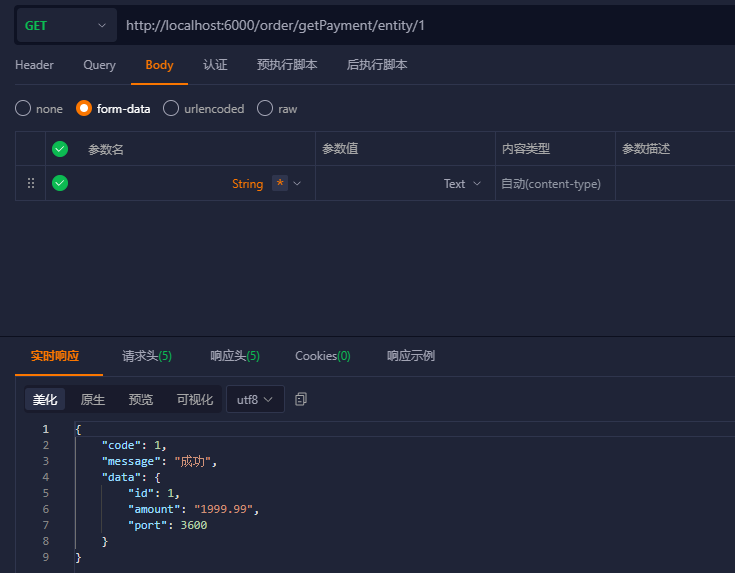Spring Cloud Ribbon(五)
Spring Cloud Ribbon
本章节的代码:https://github.com/wicksonZhang/Spring-Cloud
我们只需要聚焦在如下服务当中:
1. 基础概念
1.1. Ribbon 是什么
Ribbon是NetFlix提供的一个基于 HTTP 和 TCP 客户端的负载均衡器。主要解决了微服务架构之间服务与服务之间的通信进行负载均衡。
1.2. Ribbon 优缺点
优点
- 集成性: Ribbon 集成简单。Ribbon可以轻松的集成 Java 微服务架构中,与 Spring Cloud、
Eureka和Consul中使用。 - 负载均衡策略: Ribbon 提供了多种负载均衡算法。例如轮询、随机、加权等等。
缺点
- 不适用于非 Java 生态系统: Ribbon 主要针对 Java 平台,对于其他语言或平台的应用集成可能不那么方便。
- 依赖性: 在 Netflix 宣布不再主动维护后,Ribbon 的更新和维护可能受到限制,可能会存在安全或功能方面的风险。
1.3. Ribbon 解决了什么问题
- 服务与服务调用的负载均衡:例如,一个电子商务网站可能有多个商品服务的实例,通过 Ribbon 进行负载均衡,确保用户请求能够均匀地分布到各个商品服务实例上,提高系统的可用性和性能。
1.4. Nginx 和 Ribbon 有什么区别
Nginx:客户端所有请求统一交给 Nginx,由 Nginx 进行实现负载均衡请求转发,属于服务器端负载均衡。
Ribbon:是从 eureka 注册中心服务器端上获取服务注册信息列表,缓存到本地,然后在本地实现轮询负载均衡策略。
如下是
Nginx在微服务架构中的体现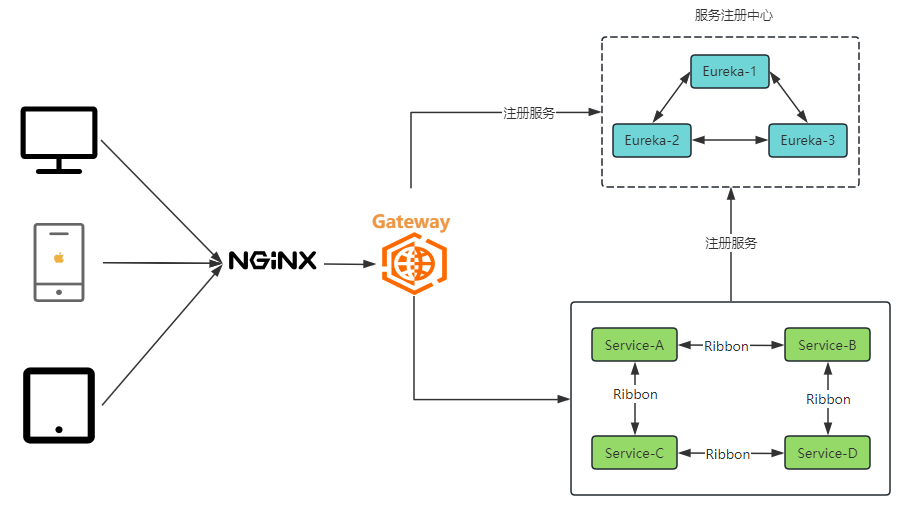
如下是
Nginx的配置,并不是配置了所有的服务代码,而是只配置一个网关即可。1
2
3
4
5
6
7
8
9
10
11
12
13
14
15
16
17
18
19
20
21
22
23
24
25
26
27
28
29
30
31
32
33
34
35
36
37
38
39
40
41
42worker_processes 1;
events {
worker_connections 1024;
}
http {
include mime.types;
default_type application/octet-stream;
sendfile on;
keepalive_timeout 65;
server {
listen 80;
server_name localhost;
location / {
root /home/ruoyi/projects/ruoyi-ui;
try_files $uri $uri/ /index.html;
index index.html index.htm;
}
location /prod-api/{
proxy_set_header Host $http_host;
proxy_set_header X-Real-IP $remote_addr;
proxy_set_header REMOTE-HOST $remote_addr;
proxy_set_header X-Forwarded-For $proxy_add_x_forwarded_for;
# 只暴露网关端口
proxy_pass http://localhost:8080/;
}
# 避免actuator暴露
if ($request_uri ~ "/actuator") {
return 403;
}
error_page 500 502 503 504 /50x.html;
location = /50x.html {
root html;
}
}
}
2. Ribbon 具体实现
实现需求
- 我们本章节的
Ribbion实现,还是基于我们Eureka的集群案例,只是不需要订单服务。采用Ribbon的服务。
- 我们本章节的
实现思路
- Step-1:创建订单服务
06-spring-cloud-ribbon-order-6000
- Step-1:创建订单服务
代码结构
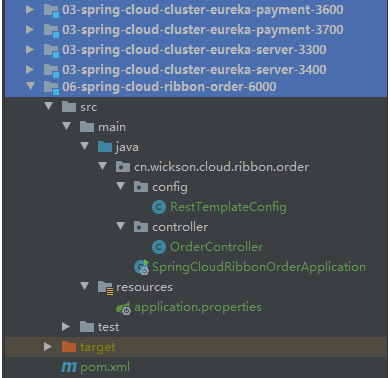
创建订单服务:
06-spring-cloud-ribbon-order-6000实现步骤
- Step-1:导入
pom.xml依赖 - Step-2:修改
application.properties文件 - Step-3:创建主启动类
- Step-4:编写业务类
- Step-1:导入
Step-1:导入
pom.xml依赖- 在
eureka-client依赖包中存在在Ribbon的相关依赖
1
2
3
4
5
6
7
8
9
10
11
12
13
14<dependencies>
<!-- 公共依赖包 -->
<dependency>
<groupId>cn.wickson.cloud</groupId>
<artifactId>01-spring-cloud-common</artifactId>
<version>1.0-SNAPSHOT</version>
</dependency>
<!-- 服务注册中心的客户端端 eureka-client -->
<dependency>
<groupId>org.springframework.cloud</groupId>
<artifactId>spring-cloud-starter-netflix-eureka-client</artifactId>
</dependency>
</dependencies>- 在
Step-2:修改
application.properties文件1
2
3
4
5
6
7
8
9
10
11
12
13
14
15# 服务端口
server.port=6000
# 应用名称
spring.application.name=spring-cloud-ribbon-order
# 是否向注册中心注册自己
eureka.client.register-with-eureka=true
# 表示自己就是注册中心,职责是维护服务实例,并不需要去检索服务
eureka.client.fetch-registry=true
# 设置与eureka server交互的地址查询服务和注册服务都需要依赖这个地址
eureka.client.serviceUrl.defaultZone=http://eureka3300.com:3300/eureka,http://eureka3400.com:3400/eureka
# 默认就是应用名称:端口,设置Eureka服务实例的唯一标识为 spring-cloud-cluster-eureka-order:3500
eureka.instance.instance-id=spring-cloud-ribbon-order:6000
# 设置Eureka客户端是否偏好使用IP地址注册到Eureka服务器,而不是使用主机名
eureka.instance.prefer-ip-address=true
Step-3:创建主启动类
1
2
3
4
5
6
7
8
9
10
11
12
13
14
15/**
* 订单服务-微服务启用类
*
* @author ZhangZiHeng
* @date 2024-01-04
*/
public class SpringCloudRibbonOrderApplication {
public static void main(String[] args) {
SpringApplication.run(SpringCloudRibbonOrderApplication.class, args);
}
}
Step-4:编写业务类
- restTemplate.getForObject:返回对象为响应体中数据转化成的对象,基本上可以理解为 Json
- restTemplate.getForEntity:返回的对象为 ResponseEntity 对象,包含一些重要信息。
1
2
3
4
5
6
7
8
9
10
11
12
13
14
15
16
17
18
19
20
21
22
23
24
25
26
27
28
29
30
31
32
33
34
35
36
37
38
39
40
41
public class OrderController {
public static final String PAYMENT_URL = "http://SPRING-CLOUD-CLUSTER-EUREKA-PAYMENT";
private RestTemplate restTemplate;
/**
* 获取订单
* restTemplate.getForObject:返回对象为响应体中数据转化成的对象,基本上可以理解为 Json
*
* @param id id
* @return ResultUtil
*/
public ResultUtil getPaymentByObject( Long id) {
return restTemplate.getForObject(PAYMENT_URL + "/payment/getById/" + id, ResultUtil.class);
}
/**
* 获取订单
* restTemplate.getForEntity:返回的对象为 ResponseEntity 对象,包含一些重要信息
*
* @param id id
* @return ResultUtil
*/
public ResultUtil getPaymentByEntity( Long id) {
ResponseEntity<ResultUtil> entity = restTemplate.getForEntity(PAYMENT_URL + "/payment/getById/" + id, ResultUtil.class);
if (entity.getStatusCode().is2xxSuccessful()) {
return entity.getBody();
} else {
return ResultUtil.failure(ResultCodeEnum.FAILURE);
}
}
}
注意: 在浏览器访问可能会出现如下情况
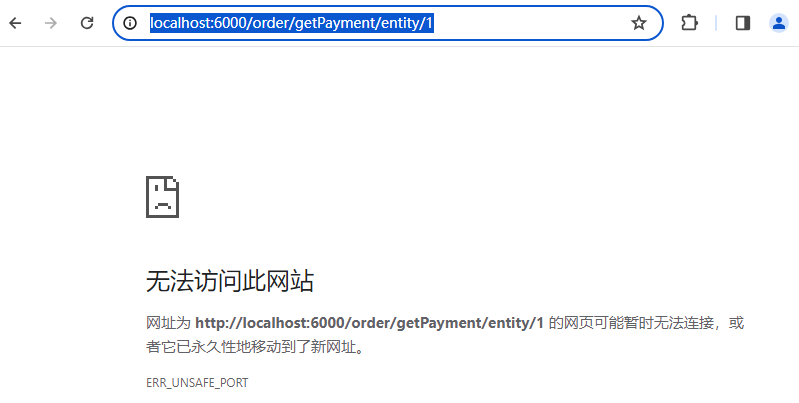
3. Ribbon 核心组件之IRule
IRule:该接口表示负载均衡的策略,其中不同的实现类代表了不同的负载策略。
如下图是 IRule 的
UML类图。
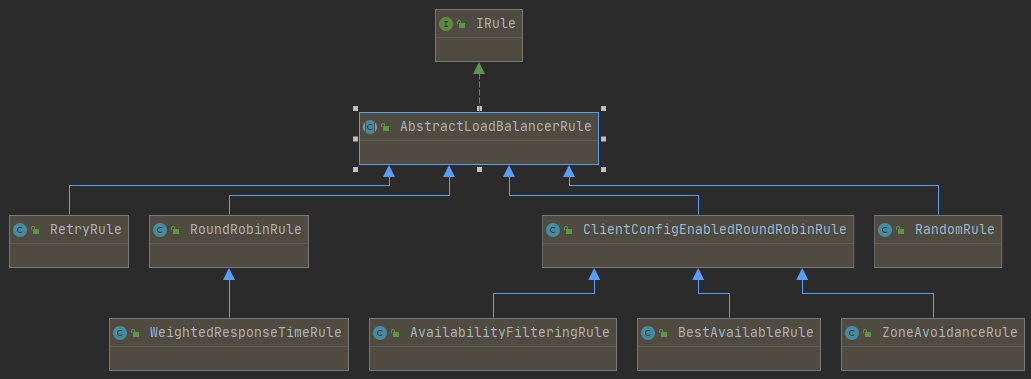
RoundRobinRule- 轮询机制:Ribbon 默认采用的也是 轮询机制。
RandomRule- 随机机制
RetryRule- 重试机制:当某个实例出现故障时,它可以尝试选择其他实例进行重试,帮助提高服务的可靠性。
WeightedResponseTimeRUle- 加权响应时间机制:权重机制是对
RoundRobinRule策略的扩展,响应的速度越快的实例权重就越大。
- 加权响应时间机制:权重机制是对
BestAvailableRule- 最佳可用机制机制:该机制会选择并发量最小的实例来处理请求,以确保选择的实例负载相对较低。
AvailabilityFilteringRule- 可用性过滤机制:该机制会过滤掉故障实例和并发连接数过高的实例,选择剩余的实例来处理请求,以确保选择的实例都是可用的且负载适中的。
ZoneAvoidanceRule- 区域避免机制:该机制会尽量避免选择和调用处于相同区域的实例,以增加系统的可用性和容错性。
3.1. 自定义负载均衡机制
我们基于上面案例进行开发
代码结构
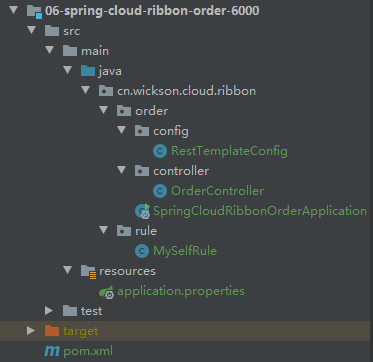
实现思路
- Step-1:自定义规则类
MySelfRule - Step-2:修改主启动类
Step-1:自定义规则类
MySelfRule- 注意:新建的
MySelfRule不要和主启动类放在同一个包下
1
2
3
4
5
6
7
8
9
10
11
12
13
14
15
16
17
18
19
20
21
22package cn.wickson.cloud.ribbon.rule;
/**
* 自定义规则
*
* @author ZhangZiHeng
* @date 2024-01-05
*/
public class MySelfRule {
/**
* 自定义随机规则
*
* @return IRule
*/
public IRule myRule() {
return new RandomRule();
}
}- 注意:新建的
Step-2:修改主启动类
- 注意:我们在主启动类新增一个注解
@RibbonClient
1
2
3
4
5
6
7
8
9
10
11
12
13
14
15
16/**
* 订单服务-微服务启用类
*
* @author ZhangZiHeng
* @date 2024-01-04
*/
public class SpringCloudRibbonOrderApplication {
public static void main(String[] args) {
SpringApplication.run(SpringCloudRibbonOrderApplication.class, args);
}
}- 注意:我们在主启动类新增一个注解
测试
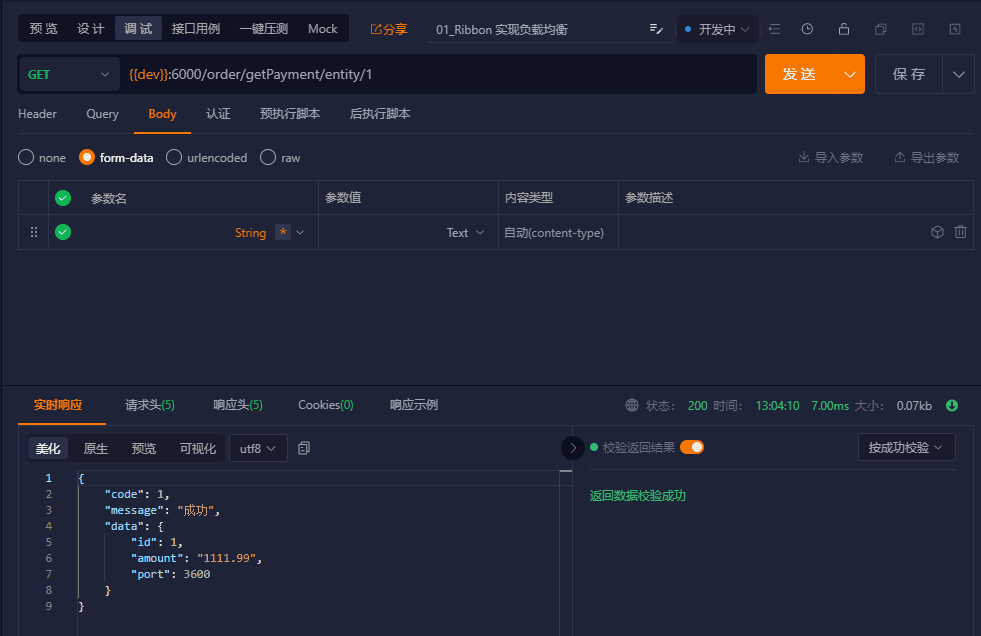
4. 负载均衡算法
- 负载均衡算法规则如下
1 | rest 接口第几次请求 % 服务器集群总数量 = 实际调用服务器位置下标 |
- 例如,假设我们存在两个实例(
3600、3700),下标分别为 0 和 1 ,按照负载均衡的轮询算法如下:
1 | 第一次请求:1 % 2 = 1,则找到下标为1的机器,服务地址为:127.0.0.1:3700 |
- 具体实现方式如下
ILoadBalance.java
1 | public interface ILoadBalance { |
LoadBalanceImpl.java- 主要是使用到了自旋锁进行实现
1 | /** |
本博客所有文章除特别声明外,均采用 CC BY-NC-SA 4.0 许可协议。转载请注明来自 Wickson Blog!
评论
